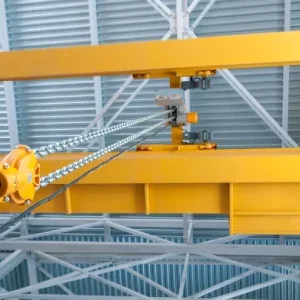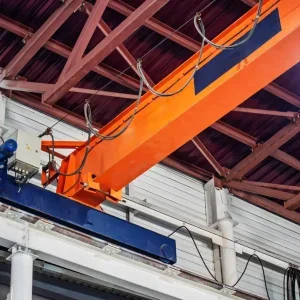Many countries now have legislation about manual handling to protect employees from the physical dangers inherent in lifting. This has stimulated much wider use of mechanical handling devices and together with the search for greater efficiency, has accelerated the trend towards the mechanisation of lifting operations. The use of lifting appliances has obvious benefits to the well-being of employees, but all such equipment naturally carries its own risks. Furthermore, correct specification is not just a safety issue; an inappropriate choice is likely to result in unsatisfactory performance and a poor return on investment.
Selecting the right lifting machine starts with a comprehensive assessment of the lifting operations concerned, including the size and nature of loads, the distance and plane of movement required, the accuracy with which the loads must be positioned, the frequency of the operation in the short and long term, the need for a suspension point/structure, the headroom and working space available, the siting – indoors or out, and the availability of electrical and/or compressed air supplies. Hostile or contaminated atmospheres must always be taken into account. Cost will inevitably play an important role too and the possibility of short-term hire should not be overlooked.
The choice between manual or power operation is one of the major decisions to be made. Manual handling legislation requires that the physical strain placed on staff during a lifting operation is considered. The effort required to operate a hand chain block or chain lever hoist varies depending on the unit and can be considerable. Furthermore, lifting speeds on such manual devices are invariably slow but they do allow loads to be raised and lowered with precision. If a suitable power supply is available and the application involves frequent lifting operations, heavy loads, or the need for speed, then the powered option is likely to be more appropriate.
Manual appliances
The simplest manual appliance is the pulley block. It is now rarely used without winches, which provide both the effort and the brake. In their absence, a pulley block is not self-sustaining. It must be remembered that the load imposed on the supporting structure by the pulley blocks includes not only the load and the equipment but also the line pull in the effort rope.
Other modern manual lifting appliances are self-sustaining. The hand chain block provides a straightforward means of performing vertical lifts of up to several metres. The load chain should be kept vertical, so they are only suitable if the load is directly under the hook. Their light weight and ease of installation makes them suited to temporary applications. Hand operated chain lever hoists offer similar facilities for shorter lifts but can operate in any position and are therefore suitable for pulling at an angle to the vertical and/or where frequent repositioning is necessary. Lifting and pulling machines using a gripping action on the wire rope also offer similar facilities but, as the rope passes through and is not stored in the machine, they are well suited to applications calling for very long lifts.
Although the operator effort required increases with the load with all manually operated appliances, most types are usually designed to be within the acceptable effort of one person. This assumes that the operator can be in the best position to apply the effort, so an allowance must be made when conditions are not ideal. A word of caution: the brake on hand chain blocks and lever hoists relies on resistance from the load and may not operate efficiently under light loads. They should work down to 5% of the SWL, but in dirty or corrosive environments this can rise. If in doubt, it is best to avoid using them at less than 10% of their SWL.
Both hand and power operated chain blocks and lever hoists are often used with travelling girder trolleys. This set-up enables the lifting machine and its suspended load to move along a track such as a runway or slewing jib. The trolley can be pushed manually, operated by a hand chain or, where applicable, powered.
Powered appliances
Compressed air, pressurised hydraulic fluid or torque from a petrol or diesel engine can be used as power sources in specialised applications, but electricity is the most widely used. For industrial use, electric powered appliances usually require a three phase AC supply, although single phase AC and low voltage DC units are available in the smaller capacities. Control of the hoist is usually by a hand held push-button pendant. For those operating on mains voltage obviously the operator must be protected against the risk of electric shock.
For the lifting medium, the choice is between wire rope and chain. Chain hoists are generally more compact and ideally suited for lower capacity applications when lifting a few metres. As the capacity and height of lift required increases, wire rope hoists become more suitable but there is a lot of overlap in the middle ground where either may be appropriate. When considering an electric hoist, duty rating and speed(s) are all-important. These are also two key factors in the price of the hoist. However, the nature of the applications is more important than the cost. If the load has to be raised or lowered with precision, then a low speed will be required, otherwise frequent inching will be necessary. This not only makes the job harder but can rapidly overheat the motor and cause the windings to fail. Electric motors do not like rapid repeat starts. If part of the operation requires more speed, then a dual speed hoist is more suitable. Another word of caution: on some hoists the slow speed is not designed for prolonged use. It is intended only as a stepping stone to full speed. The duty rating of the slow speed motor windings can be much lower than that of the full speed windings. Always check whether the duty rating quoted applies to both.
The duty rating of the hoist takes into account several factors. A hoist which always lifts loads close to its SWL and works long hours clearly needs to be more robust than one normally working well below its SWL and intermittently. A hoist of inadequate duty rating for the job will have a shorter life and will need more frequent maintenance and inspection to ensure that it remains safe to operate and reliable. The initial saving in purchase price may therefore soon be lost. Moreover if it is used in a duty cycle beyond its rating, the motor windings can very quickly overheat and fail long before the hoist wears out mechanically, resulting in an expensive repair.
Although the push-button pendant is the most common control for electric hoists, there are other options. Wall-mounted buttons may be more appropriate for multi-station applications, and remote control systems are particularly relevant where direct access to the load and lifting appliance is difficult or dangerous.
Safety devices
Safety devices that were once regarded as optional are increasingly standard features of power operated hoists and winches. The British Standard BS 466 requires that power operated wire rope hoists are provided with an upper hoisting limit. This prevents the bottom hook travelling up into the hoist body, which would result in the wire rope breaking and the load being dropped. Bottom limits are also commonly offered as standard. In their absence, a hoist can be over-lowered and the rope wound onto the drum in the reverse direction. It should be stressed that hoisting and lowering limits are safety devices designed for occasional use, and they must not be used to position the bottom hook. Another device is available to perform that function, if required. Safety also demands that where more than one appliance travels under power on the same track, anti-collision and approach limiting devices are fitted.
Overload protection should also be considered at the specification stage. Manually operated appliances often rely only on the effort to lift the load exceeding the user’s line pull. A shear pin is usually used on lifting and pulling machines which use a gripping action on wire rope (and similar appliances) to prevent excessive effort being applied to the operating lever. On power operated chain hoists, slipping clutches are often used to protect against overload. Alternatively, load measuring and sensing devices can be used to prevent overload by stopping the appliance from lifting if the load is in excess. Such devices are now standard on many models.
Whatever method is used, it will only operate to prevent an excessive load being lifted by the machine. If the load is imposed externally the machine will still be overloaded. This is particularly relevant if more than one machine is used to handle a load because, during lowering, one machine can get ahead and transfer its share of the load to another.






